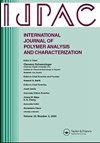在可见光下降解罗丹明 B 的赤铁矿(Fe2O3)改性生物聚合物
IF 1.6
4区 工程技术
Q4 POLYMER SCIENCE
International Journal of Polymer Analysis and Characterization
Pub Date : 2024-10-02
DOI:10.1080/1023666X.2024.2383846
引用次数: 0
摘要
本研究通过将赤铁矿α-Fe2O3加入到华盛顿(Washingtonia filifera)棕榈树的原叶和提取物中,制备出一种新型生物材料。本文章由计算机程序翻译,如有差异,请以英文原文为准。
Hematite (Fe2O3)-modified biopolymer for Rhodamine B degradation under visible light
This study deals with the preparation of a novel biomaterial by incorporating the hematite α-Fe2O3 onto crushed leaves of the Washingtonia filifera palm tree in their raw state and in extracted cellulose from the same plant. The incorporation of α-Fe2O3 was accomplished by hydrothermal route at 200 °C. The palm leaves, extracted cellulose, and synthesized products were characterized by thermal analysis (TG) and FT-IR spectroscopy. The latter revealed peaks at 524 and 449 cm−1 for the synthesized material, attributed to vibrational deformation of the inorganic Fe-O bond. In contrast to the TG profile of raw palm leaves, the thermogram of the composite degrades in a single step at 343 °C. This one-step decomposition clearly indicates the chemical modification of our cellulose matrix and confirms the successful incorporation of the hematite α-Fe2O3 into the lignocellulose. The second part is devoted to α-Fe2O3 working as sensitizer in photocatalysis, it was characterized optically (E g= 1.94 eV) and electrochemically with a flat band potential of −0.53 VSCE. The conduction band (−0.73 VSCE) is more cathodic than the potential of the O2/O2•− couple (−0.52 VSCE) and should reduce dissolved oxygen into reactive O2•− radical. The as-prepared materials were successfully tested in the photocatalytic degradation of Rh B (10 ppm) and the result gave an abatement of 60% on α-Fe2O3/lignocellulose under visible light irradiation (LED lamp) with a flux of 23 mW cm−2. The kinetic obeys a first-order model with a half photocatalytic-life of ∼ 7 h.
求助全文
通过发布文献求助,成功后即可免费获取论文全文。
去求助
来源期刊
CiteScore
3.50
自引率
5.30%
发文量
37
审稿时长
1.6 months
期刊介绍:
The scope of the journal is to publish original contributions and reviews on studies, methodologies, instrumentation, and applications involving the analysis and characterization of polymers and polymeric-based materials, including synthetic polymers, blends, composites, fibers, coatings, supramolecular structures, polysaccharides, and biopolymers. The Journal will accept papers and review articles on the following topics and research areas involving fundamental and applied studies of polymer analysis and characterization:
Characterization and analysis of new and existing polymers and polymeric-based materials.
Design and evaluation of analytical instrumentation and physical testing equipment.
Determination of molecular weight, size, conformation, branching, cross-linking, chemical structure, and sequence distribution.
Using separation, spectroscopic, and scattering techniques.
Surface characterization of polymeric materials.
Measurement of solution and bulk properties and behavior of polymers.
Studies involving structure-property-processing relationships, and polymer aging.
Analysis of oligomeric materials.
Analysis of polymer additives and decomposition products.

 求助内容:
求助内容: 应助结果提醒方式:
应助结果提醒方式:


